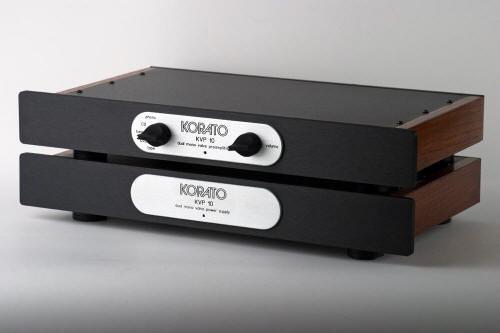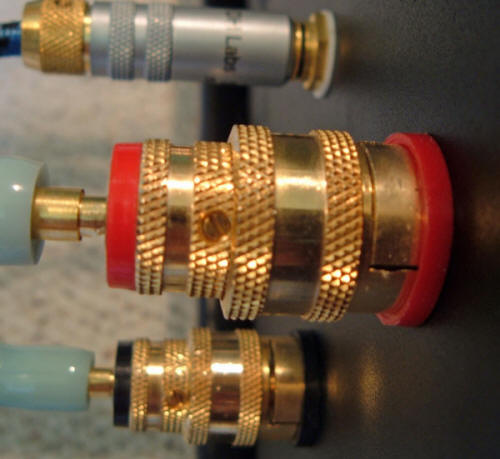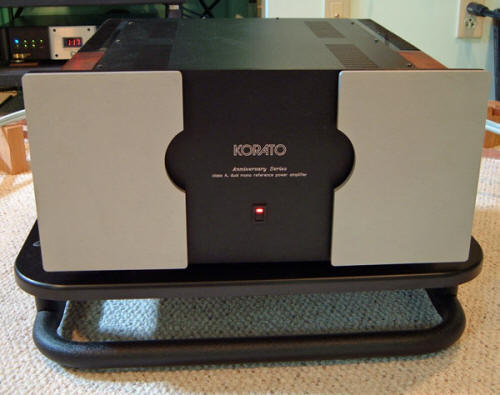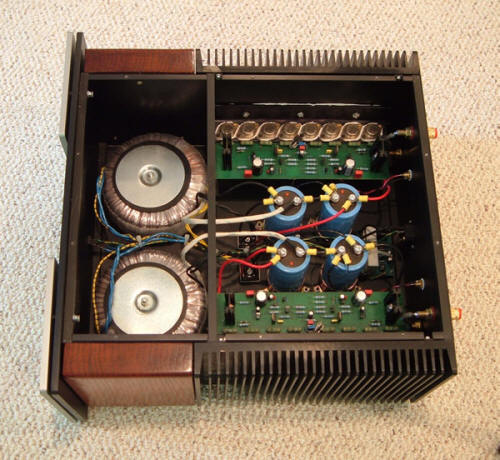
You are reading the older HTML site
Positive Feedback ISSUE
44july/august 2009
korato
KVP-10 preamplifier and Anniversary amplifier
as reviewed by Kent Johnson

|
KENT JOHNSON'S SYSTEM
LOUDSPEAKERS
ELECTRONICS
SOURCES
CABLES
ACCESSORIES SECOND SYSTEM
LOUDSPEAKERS
ELECTRONICS
SOURCE
CABLES
ACCESSORIES
|
I spoke with Bryan Pape of BSP Audio, the Korato importer, about reviewing a Korato component just after Rocky Mountain Audio Fest 2008. It took until early June 2009 for that to happen. It was worth the wait.
Description
Korato components are made in Serbia. Both the KVP-10 preamplifier and Anniversary amplifier are dual mono designs; the only thing common to both channels is the power cord. Both components are minimalist in design and appearance, substantially built, nicely finished, and use Vanden Hul wiring internally as well as other high-quality audiophile parts. They truly look like high-end equipment and impart a sense of pride-of-ownership from just having them in the room. While attractive, the Koratos also manage to convey the impression that no money that could have been spent on making them sound good has been wasted on simply making them look good. Form following function has clearly informed their design.
The KVP-10 Preamplifier
The KVP-10 preamplifier's Power Supply is in a separate chassis from the Control Unit. Both chassis are identical in size and measure approximately 17 by 10.5 by 2.5 inches with an 8mm thick 19-inch faceplate.
There is a red on/off indicator led on the front of the Power Supply, an IEC AC jack on the rear center, and a pair of multi-pin output connections, right and left, for the umbilical cords that connect it to the Control Unit. The Power Supply feels very dense and does generate a moderate amount of heat in use. It uses two ECL 82 tubes for voltage regulation.

High-quality parts are used in the KVP-10 Control Unit including Mundorf capacitors and an Alps Black Beauty volume control. (An optional $250 radio frequency remote control is available.) The KVP-10 is a zero-feedback design.
With only two knobs, one for selection between five different inputs and a volume control, both of which have a high-quality feel to them, the front of the Control Unit would be hard to simplify further. The rear panel has very good quality gold-plated RCA input jacks, a set of output jacks for the amplifier, and record-out jacks. There are also the input cable connections from the Power Supply at either side. Two 12AU7 tubes are used in the Control Unit but there is negligible heat generated by them during playback.
A four tube phono preamp section is available for the KVP-10; the review sample did not have this option.
I know that it is early in the review but I am going to note here my only complaint regarding the operation of this preamp. The Alps volume control's overall travel extends from about 7 o'clock to 5 o'clock. All of my listening was done from 7:45 to 8 o'clock, however, which either provided a range from too soft to too loud with both the Anniversary and my Rogue 90 amplifier. It was difficult to make fine adjustments in volume as the control is presently configured. A larger range of adjustment, if possible, would be very welcome.
The Anniversary Amplifier
To my eye, the front of the Anniversary amplifier echoes the faceplate aesthetics of current Pass amplifiers, while being far simpler. The only control is an on/off power switch with built-in indicator light. The Korato name is simply engraved into the faceplate. I can't help but feel that the front of this amp needs something more. It is overly simple for a $4600 high-end amplifier. Perhaps the Korato name should to be backlit? What about a temperature readout that monitors the heat sinks? That would be cool and I don't think it has ever been done. Just a thought.
Regarding the heat sinks… the Anniversary amplifier's are large and are not merely for display. This amplifier develops 180-WPC, the first 40 of which are in Class A; meaning the heat sinks get very warm. They never got too warm to touch, but I would not want to hold my hand on them for any extended period of time.
The rear of the amp has connections for an IEC AC cord and two gold RCA input jacks. There are also four very well made speaker binding posts. I have never seen this binding post before but it is cleverly made and allows for using large spades or bare wires as well as 4mm/banana plugs, which is what I used.

The Anniversary amp is large and very heavy. It measures 19 inches wide by about 20 inches deep, with connectors, by 9 inches tall and weighs 64 pounds. This weight comes largely from the two very hefty toroidal transformers that form its power supply. The circuit design, according to Bryan, "is conventional but uses very high quality components with a great deal of attention paid to the layout of the circuitry."
Update
Before addressing the sonic characteristics of the Korato equipment, I feel that I should mention some changes that I have made to my listening room since reviewing the Teresonic Clarison Silver interconnect cables in Issue 43 of PFO.
My listening room is in a walk-out basement and has had an eight-foot, single-pane, all-glass patio door at its North end. I should have replaced this door when I built my room but was reluctant to lose the light it provides. Unfortunately, in addition to allowing light in, it allows outside air and bugs to come in, pretty much at will, due to its inability to close tightly. Thanks to its single-pane glass, it literally drips condensation in the winter and grows mold in its tracks. I finally had enough and removed it in late April.
I hired a carpenter and we installed a normal exterior door and framed in the rest of the opening with 2 by 6 studs. This allowed me to use R-19 insulation in the new section of wall. I have the exterior done but still have some interior trimming and drywall repairing to do. I don't expect to do this until it cools off this fall.
The result of this renovation has been a noticeably quieter listening space. My room was very quiet to begin with, but now it is REALLY quiet. I have been discovering very low level details on already-familiar CDs. As an example, the train whistle on "Train Song" from Holly Cole's Temptation (Metro Blue D 102024) toots softly several times in the rear of the soundstage. I had always heard the toots; what I did not hear was how the last toot actually continues to fade into silence. I have been hearing similar sorts of details on numerous other recordings as well.
I have also spent some time repositioning my Magneplanar MG1.6 speakers. They are now farther apart and angled more towards my listening chair. This has resulted in a larger soundstage, which, coupled with the quieter room, has resulted in what I feel is a significant improvement in the performance of my system.
It cost me about $1100 to replace the patio door—not a great deal of money if we were talking about upgrading components. Yet I doubt that there is any component I could have purchased that would have provided the same amount of audible improvement.
There is no question in my mind that the most important component in any system is the room. The Korato components are the first equipment I have reviewed to benefit from this renovation.
Listening
I did my listening to the Korato pair using my reference DH Lab Revelation interconnects. The power cord on the Anniversary amp was a PS Audio Prelude. Speaker cables were Supra Swords configured as a stereo pair. I will report further on the Sword cables in the near future.
Bryan brought with him an AC power cord that was new to me from a company called IeGO. This AC cord uses 99.97% pure copper wiring. The IEC and plug ends are copper and appear to be of very good quality. While thick, the cord is fairly flexible.
Before listening to the Korato equipment, I tried this cord on my Dodd preamp in place of the PS Audio Plasma that I have been using. There was a clear improvement in soundstage definition with the IeGO so I used it with both the Dodd and Korato preamplifiers. The IeGO sells for $80. I understand it is their least expensive AC cable. (www.acoustic-fun.com)
Both Korato components were already broken-in and sounded good almost immediately. Even so, after about twenty to thirty minutes of use their sound improved somewhat further and remained consistent from that point on. Due to the heat they both generated, I shut them off when not in use.
Listening to the Korato KVP-10
I began serious listening by replacing the Dodd preamp with the Korato KVP-10. The KVP-10 and my Rogue 90 amplifier could not have gotten along better. The music they made was gorgeous. I had a huge soundstage with excellent focus and stability, tons of low-level detail, clean lustrous treble, and bass with excellent depth, definition, and slam. Were it not for a particularly annoying voice in the back of my head reminding me that I was supposed to write about what I was hearing, I would probably have never taken any notes at all. The minimal notes I did take remark on two aspects of the Korato/Rogue combination's performance.
The first is how realistic everything I listened to sounded: the usual assortment of female vocalists, string quartets, small orchestras, and jazz ensembles and with all of them I felt an immediate connection. It was very much a case of Performer/Listener, not Performer/System/Listener.
The illusion of being in the room with the performers was as tangible as I have ever felt prior with my system. Shelby Lynne's Just a Little Lovin' CD, for example, was stunning. The metallic clarity of the individual cymbal strikes on "Just a Little Lovin'" sounded utterly real. The pain her voice conveys on "Anyone Who Had a Heart" is as emotionally unsettling for the listener as it is for the singer. If there is anyone who has ever doubted how important the silences between the notes are to musical expression, this CD provides a definitive tutorial on the subject. (Lost Highway B0009789-02)
No less impressive was the Ludvig Berghe Trio's "Lament for an Unplayed Venue" in which the bowed acoustic bass is played as if it were a tree being sawed down—the result was woody, visceral, and raw in its directness. The bass doesn't merely draw your attention, it commands it while providing a foundation against which the performance of the piano can reply. (M.M.P. CD055)
Bernstein and the Los Angeles Philharmonic's performance of Copland's "Appalachian Spring" was beautiful, showcasing both the control Bernstein exerts over the orchestra and the subsequent way in which the music flows. Dynamics were excellent; but most impressive were how the soft, subtle, and delicate passages were beautifully formed. It was just gorgeous. (DG 289 469 277-2)
The second thing the KVP-10 brought to the performance was a slightly better sense of bass depth. This became obvious only with extended listening but I felt that subjectively the low bass extension of the Korato preamp was just a nudge better than that of my reference Dodd.
Listening to the Korato Anniversary Amplifier
Replacing the Rogue amplifier with the solid-state Korato Anniversary amplifier resulted in a sound that was in most respects only subtly different. The big soundstage remained as did the top to bottom neutrality throughout the frequency range. The ability of this combination to reproduce delicate low-level passages was as good as my reference equipment. There was no sense of any part of the frequency spectrum being reproduced as anything other than completely accurately. The differences that were evident surfaced in completely predictable areas—vocal reproduction and bass performance.

Music lost a minute amount of the richness and body that I had heard with the all-tube set up. This loss was primarily evident with female voice. The longer I listened to the Korato duo, the more I grew accustomed to its presentation, the more difficult it became to feel a lot of confidence in this assessment, however. Vocals were reproduced by the Korato duo with lots of detail and with their emotional impact intact. Voices were attached to tangible human bodies. The longer I listened, the more evident it was that the Korato pair was bringing an indisputable vitality to the music that more than compensated for any small loss of tangibility. Music sounded real with an innate, insistent forward momentum regardless of the genre.
Given the power at its disposal, I expected the Anniversary amplifier to offer an immediate and noticeable increase in bass volume and impact. Where called for in the music this is exactly what transpired. My MG1.6s offered impressive bass slam and extension that was both taut and well defined on about 90% of the recordings I listened to. I also listened to recordings where the amount of bass present was truly impressive out of the 1.6s even if the definition could have been better (the other 10%). I still enjoyed the bass performance immensely. It is hard to be critical while listening to your speakers do things you never expected them to do.

What was equally interesting to me was how, on many recordings, the overall improvement in bass performance revealed itself in a much understated fashion. While overall bass volume levels were effectively unchanged, within the soundstage individual instruments were clearly benefitting from the Anniversary amp's impressive power and control.
Dead Can Dance's Into the Labyrinth illustrated this on tracks 2 ("The Ubiquitous Mr. Lovegrove") and 4 ("The Carnival is Over"). (4AD 9 45384-2) Drums at the back of the soundstage were not obviously louder but were unmistakably more dimensional. Instead of a two-dimension drum hit at the rear of the soundstage, the drum was now audible as a three-dimensional instrument with space around it and a harmonic envelope accompanying its sound. Drums on the vast majority of recordings that I listened to sounded tauter, faster, crisper, and more three-dimensional through the Korato but only modestly louder. Bass balance and definition was never sacrificed on the altar of volume. I found this quality as impressive as the Anniversary amplifier's ability to find substantially more output from the low end of the MG1.6s.
A Little Tube Rolling
The circuitry in the KVP-10 preamplifier is very simple. The 12AU7 forms a significant portion of that circuitry so Bryan offered me the chance to hear something other than the stock tubes, which are made by Ei. He brought a pair of RCA 12AU7 black plates when he came to pick up the preamplifier. We also listened to some new Philips JAN 6189 tubes that I had.
I did all of the listening noted above with the stock tubes and not only enjoyed it immensely, but never felt that the sound needed any improving. Still, I was curious as to how different tubes might or might not affect the tonal balance of the preamp.
Listening to the RCA black plate tubes produced music with very slightly less treble energy but discernibly more bass depth and definition. The midrange was unaffected. The Philips tubes restored the treble energy of the Ei tubes while retaining most of the bass performance of the RCAs with, again, no obvious affect on the midrange.
I hasten to add that these impressions were the product of a relatively short listening session. To someone just wandering into my listening room, the sound would have been glorious with any of the tubes. For tube fans, the possibility of tailoring the sound of the preamp slightly by one's choice of tubes will be a welcome capability.
Summary
I have not had the opportunity to listen to any really expensive high-end audio equipment in my own system. (Although there is clearly an upward creep in the prices of the equipment I have been reviewing.)
So I cannot say how the Korato equipment compares to components at two, three or four times their price, except to wonder how they could possibly improve upon the Korato pair in any significant way.
The Korato KVP-10 and Anniversary amplifier are fabulous music-making components. They offer a vivacious propulsive sound that reproduces music with both beauty and life. If I woke up tomorrow and found my Dodd preamp and Rogue amp replaced by the Korato equipment, there would be absolutely no complaint on my part. Yes, the Korato pair does sound slightly different than an all-tube set up but that difference is akin to preferring one tenor's voice over another's. Listening with the Korato equipment, you will know exactly how each tenor sounds and have no doubts as to which tenor you actually prefer. The difficulty will be to concentrate on his singing and not get swept away with the music. Absolutely wonderful! Kent Johnson
KVP-10 Preamplifier
Retail: $1995
Optional Remote
Retail: $250
Optional Tube Phono
Stage
Retail: $300
Anniversary Amplifier
Retail:
$4600
Korato
www.bspaudio.com

